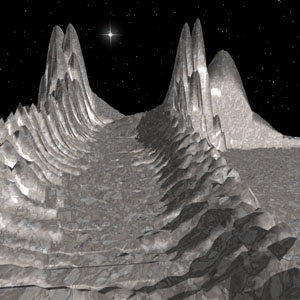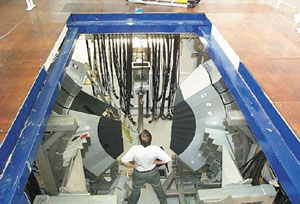Some 15 years ago, an ambitious plan to create a neutron source out of an aging particle accelerator came to fruition. Today, accelerator, detector and data acquisition developments continue to play an important role in keeping ISIS at the forefront of neutron science.

ISIS, the major facility at the Rutherford Appleton Laboratory (RAL) in Oxfordshire, UK, is the world’s most powerful pulsed spallation neutron source. Since 1984 it has provided beams of neutrons and muons that have enabled the structure and dynamics of condensed matter to be probed on a microscopic scale ranging from the subatomic to the macromolecular, from a proton wavefunction to a protein structure.
Neutron production
Construction of the source was approved in 1977, following a proposal by UK scientists who saw an opportunity to build a world-leading neutron facility replacing the aging NIMROD proton accelerator at the then Rutherford Laboratory. In contrast with the traditional means of neutron production by nuclear fission, which involves the production of a continuous stream of neutrons, ISIS was to be a pulsed neutron source, similar to but much more intense than the existing IPNS source at Argonne National Laboratory in Illinois, US.
First, H– ions would be accelerated in a pre-injector column to 665 keV, then passed into a linear accelerator consisting of four accelerating RF cavities, reaching an energy of 70 MeV. At the point of injection into the final acceleration stage (a 52 m diameter proton synchrotron), the electrons would be stripped from the H– ions by a 0.25 mm alumina foil, to produce a circulating beam of protons.

At full intensity, 2.5 x 1013 protons per pulse would be accelerated to 800 MeV, before being extracted and sent to a heavy metal target, producing a burst of neutrons by spallation. This whole process would then be repeated 50 times per second.
As a result of the low duty cycle of the ISIS accelerator, the time-averaged heat production in the ISIS target would be a modest 160 kW, but, in the pulse, the neutron brightness would exceed that of the most advanced steady-state sources. In addition, the structure of the neutron pulse would be exploited using time-of-flight measurement techniques and white neutron beams, thereby providing a direct determination of the energy and wavelength of each neutron detected. The duty cycle of the accelerator would also ensure good signal-to-noise levels.
The first neutrons were produced in late 1984 and ISIS was officially inaugurated in October 1985. The facility reached its design specification of delivering 200 mA pulses to the target station in 1993, and it has run more or less consistently at this level since then.
Leading edge science

Over the past 15 years, ISIS has attracted substantial international investment and has developed into a major international force in condensed matter research. It has seen its complement of instruments rise from 6 to more than 20 and its user base from 200 to more than 2000. This popularity reflects the fact that the neutron is in many ways the ideal probe for the study of solids and liquids.
The citation for the 1994 Nobel Prize for Physics to Brockhouse and Schull for their pioneering work in neutron scattering put this point succinctly – neutrons simultaneously probe the structure and dynamics of matter, bringing insight at an atomic and molecular level about where atoms “are” and what atoms “do”.
Structural and dynamical studies at ISIS have had a major impact at the cutting-edge of materials development at both the fundamental and the applied levels. ISIS has been heavily involved in many of the most exciting stories of recent years, including the physics “Woodstock” of high Tc superconductors and the discovery of a new form of carbon, C60 (Buckminsterfullerene). On the applied side, work at ISIS underpins the development of materials such as batteries, detergents, catalysts, pharmaceuticals and polymers.
More data faster

Over the past 15 years the problems tackled at ISIS have become ever more diverse and challenging. The desire to collect more data faster has become irresistible, as areas such as in situand time-resolved studies on increasingly complex systems become more important. To handle this trend, detector arrays have expanded enormously from those originally installed, employing “spin-off” technology borrowed from high-energy physics techniques.
Next-generation instruments at ISIS, such as the new MAPS spectrometer and the GEM diffractometer, now include detector arrays with areas as large as 16 m2 – orders of magnitude larger than those available in 1984 and containing more than 50 million data points per measurement. Much of the development of these new neutron detectors, both in terms of front-end construction and signal encoding, has been undertaken at RAL.
In tandem with these large detector arrays, the data acquisition and storage systems at ISIS must also be state of the art to handle the huge volumes of data generated. ISIS instruments operate to a common data acquisition framework based on the RAL-developed electronics. The ability to develop, build and support such advanced systems in house has again relied a great deal on experience gained from RAL’s historical and continuing involvement in other aspects of high-energy and particle physics.
Looking to the future
While the trend towards massive detector arrays is one way of increasing the number of neutrons utilized in an experiment, developments in the synchrotron ring are taking place that will increase the current that can be delivered to the target to 300 mA.
This involves the addition of a second harmonic to the existing accelerating RF waveform, achieved by the insertion of four new RF cavities into the existing ring. As well as benefiting all of the instruments clustered round the existing target station via increased neutron production, this enhanced current can be shared with a second target station optimized for the production of longer-wavelength cold neutrons, opening up new research opportunities in fields such as complex macromolecular assemblies, magnetism, colloid and surface chemistry, high-resolution diffraction and the biological sciences. Furthermore, the enhanced current will be essential if the SIRIUS project, which aims to utilize the spallation source as a method of producing radioactive nuclei for post-acceleration, is to become a reality.





